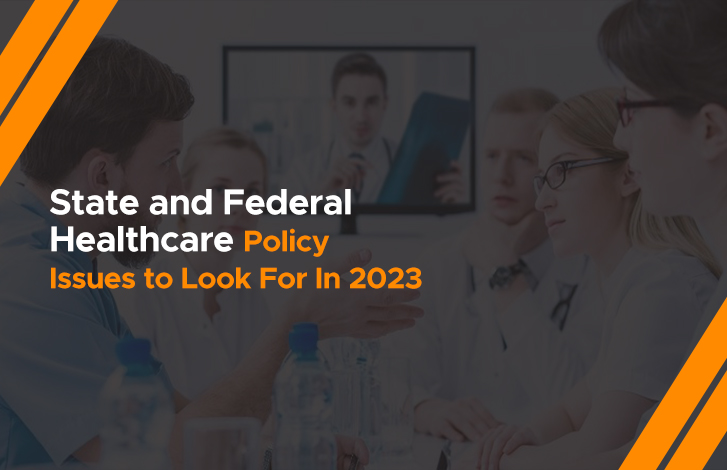Healthcare policy is a multifaceted and ever-changing field that impacts millions of Americans annually. It determines how we access and pay for health services, from the cost of medications to the quality of care and innovation in the field. In 2023, lawmakers and regulators at both the state and federal levels are expected to address several healthcare policy issues that could have far-reaching consequences for patients, providers, payers, and pharmaceutical companies.
Some key issues to monitor in 2023 include access to care, medication costs, and quality of care. These issues are at the forefront of healthcare policy discussions and can shape the future of healthcare in America. As lawmakers and regulators work to address these challenges, it will be important for all stakeholders to stay informed and engaged in the policy-making process. Here are some of the key issues to watch for in 2023.
Provider Status for Pharmacists
Pharmacists are among the most accessible and trusted healthcare professionals in the country, providing essential services such as medication dispensing, counseling, immunization, chronic disease management, and point-of-care testing. However, pharmacists are not recognized as providers under federal law, which limits their ability to be reimbursed for their clinical services by Medicare and other payers. This creates a barrier for pharmacists to practice at the top of their licenses and deliver optimal patient care.
In 2023, there may be renewed efforts to grant pharmacists provider status at the state and federal levels. According to the National Alliance of State Pharmacy Associations (NASPA), legislation impacting pharmacists’ scope of practice was introduced in 38 states in 2022, with 26 of those states enacting changes in the law. These changes include allowing pharmacists to prescribe certain medications, administer COVID-19 tests and vaccines, and collaborate with physicians through collaborative practice agreements.
At the federal level, the Pharmacy and Medically Underserved Areas Enhancement Act (H.R. 2759/S. 1362) was reintroduced in Congress in 2021 with bipartisan support from over 300 cosponsors. The bill would amend the Social Security Act to enable Medicare Part B to cover pharmacist-provided services in medically underserved areas. The bill has been endorsed by several pharmacy organizations, such as the American Pharmacists Association (APhA), the National Community Pharmacists Association (NCPA), and the American Society of Health-System Pharmacists (ASHP).
If passed, the legislation would enhance care access and medication compliance for millions of individuals covered by Medicare. It would also provide pharmacists with new opportunities to showcase their contributions to improve patient outcomes and reduce healthcare expenses.
Medication Cost Transparency
Medication costs are a major concern for many Americans, especially those with chronic conditions or high-deductible health plans. According to a survey by CoverMyMeds, nearly 6 in 10 patients said they learned at the pharmacy counter that their medication cost more than expected in the last year. Moreover, a third of patients reported altering their medication schedule to make it last longer. Over 25% had to sacrifice paying bills or purchasing necessities in the past year to afford their medications. 17% even stopped buying their medications altogether to pay for household expenses.
To address this issue, several state and federal healthcare policy initiatives aim to increase medication cost transparency at the point of prescribing and dispensing. For example, some states have passed laws requiring pharmacy benefit managers (PBMs) to disclose drug pricing information to prescribers, pharmacists, and patients, such as the wholesale acquisition cost (WAC), the average wholesale price (AWP), the maximum allowable cost (MAC), and any rebates or fees associated with a drug. Some states have also mandated PBMs to provide real-time benefit tools (RTBTs) that allow prescribers to see patient-specific formulary information, prior authorization requirements, copayments, coinsurance, deductibles, and lower-cost alternatives at the time of prescribing.
At the federal level, CMS has proposed a rule requiring Medicare Part D plans to implement RTBTs by January 1st, 2023. The rule would also require Part D plans to provide enrollees with an online tool to compare drug prices across pharmacies and mail-order services. CMS estimates that these tools could save Medicare beneficiaries up to $3.4 billion over ten years by enabling them to choose lower-cost drugs and pharmacies.
By increasing medication cost transparency at the point of prescribing and dispensing, these policy initiatives could help patients make more informed decisions about their medications, reduce sticker shock and medication abandonment, and lower their out-of-pocket expenses.
Accumulator Adjustment Programs
Accumulator Adjustment Programs (AAPs) are a controversial practice used by some health plans and PBMs to limit the impact of manufacturer copay assistance programs on plan spending. Copay assistance programs are designed to help patients with high-cost specialty drugs afford their copayments or coinsurance, by providing coupons, cards, or vouchers that cover part or all of the cost. However, some health plans and PBMs do not count the amount of copay assistance toward the patient’s deductible or out-of-pocket maximum, effectively resetting the patient’s cost-sharing obligation once the copay assistance is exhausted. This can result in patients facing unexpected and unaffordable bills for their medications, leading to medication nonadherence, poor health outcomes, and increased healthcare utilization.
In 2023, several state and federal healthcare policy proposals may seek to regulate or prohibit the use of AAPs by health plans and PBMs. For instance, some states have passed laws that require health plans and PBMs to count any form of payment made by or on behalf of a patient toward the patient’s deductible and out-of-pocket maximum, regardless of the source. Some states have also banned health plans and PBMs from excluding drugs from coverage or imposing additional cost-sharing requirements if a patient uses copay assistance.
At the federal level, CMS has issued guidance that clarifies that AAPs are not allowed for drugs without a generic equivalent under the Affordable Care Act (ACA). The guidance also states that health plans and PBMs must disclose the use of AAPs to enrollees and CMS and that CMS will monitor the impact of AAPs on patient access and affordability. Additionally, a bill called the Copay Assistance for Patients Act (H.R. 4669) was introduced in Congress in 2021, which would prohibit health plans and PBMs from using AAPs for any prescription drug covered under a health plan.
By restricting or banning the use of AAPs by health plans and PBMs, these policy proposals could protect patients from unexpected and unaffordable medication costs, improve medication adherence and health outcomes, and reduce healthcare spending.
Looking Ahead to 2023
In general, 2023 won’t bring about major changes in healthcare. However, small steps could significantly help providers recover and prepare for future challenges. By granting pharmacists provider status, increasing medication cost transparency, and regulating accumulator adjustment programs, state and federal healthcare policymakers could improve access to care and medication affordability for millions of Americans while supporting innovation and quality in the healthcare system.
Conclusion
Healthcare policy is a complex and dynamic field affecting millions of Americans annually. In 2023, several state and federal healthcare policy issues are expected to be on the agenda of lawmakers and regulators, with potential implications for patients, providers, payers, and pharmaceutical manufacturers.
By granting pharmacists provider status, increasing medication cost transparency, and regulating accumulator adjustment programs, state, and federal healthcare policymakers could improve access to care and medication affordability for millions of Americans while supporting innovation and quality in the healthcare system.
These policy initiatives could also create new opportunities and challenges for the healthcare stakeholders involved, requiring collaboration and adaptation to meet patients and the public’s evolving needs and expectations. As the healthcare landscape changes, staying informed and engaged with the policy issues that matter most to you and your health is important.







